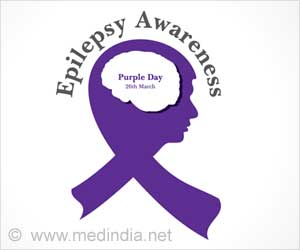Purple Day for Epilepsy 2022 observed on March 26th gathers thousands of people across the world together to start conversations about epilepsy, raise awareness of the condition and fundraise to make a difference in the lives of people affected by epilepsy.
What is Purple Day?
The Purple Day was created by Cassidy Megan, a young girl from Canada who has epilepsy and wanted people to talk about the condition in 2008.
She decided to use the color purple because lavender is recognized as the international flower of epilepsy, and symbolizes loneliness. Cassidy wanted to not only raise awareness but also assure people living with epilepsy that they were not alone.
In 2009, The Epilepsy Association of The Maritimes (EAM), along with The Anita Kaufmann Foundation, launched Purple Day internationally.
The combined efforts of Cassidy Megan, EAM, and The Anita Kaufmann Foundation have led to the involvement of numerous organizations, schools, businesses, politicians, and celebrities around the world.
How to Join the Campaign?
- Host a Purple Day party or fundraising event.
- Set up an educational display in your workplace or school to promote education about epilepsy and seizures.
- Conduct a seizure first aid training program at your workplace or school.
- Ask local businesses to help you promote Purple Day.
- Share Purple Day information and epilepsy facts on your Facebook and/or Twitter accounts.
- Take Purple Day to the next level by adding a Purple Day ribbon to your social networking accounts.
- Donate your Facebook Status – Copy the message, “On March 26, I’m wearing PURPLE to support EPILEPSY AWARENESS.” Help spread the word to your Facebook status!!
- Organize a local walk- or run-in support of Purple Day and epilepsy.
- Talk about epilepsy and/or Purple Day in your blog or vlog.
Learn Quick Facts About Epilepsy
- Approximately 50 million people around the world live with epilepsy making it one of the most common neurological diseases globally.
- The risk of premature death in epilepsy is three times higher than for the general population.
- In many parts of the world, people with epilepsy and their families suffer from stigma and discrimination.
- Epilepsy is neither a contagious disease nor a psychological disorder.
- There is currently no cure for epilepsy. However, for 10% to 15% of people with epilepsy, the surgical removal of the seizure focus the part of the brain where the person’s seizures start can eliminate all seizure activity.
- For more than half of people with epilepsy, medication can help to control their seizures. Some children will outgrow their epilepsy, and some adults may have a spontaneous remission.
- Identify specific events or circumstances that affect seizures. Some common triggers include:
Together we can help 65 million people living with epilepsy. Mark the March with purple.
References :
- About Purple Day – (https://www.purpleday.org/about/)
- What is Purple Day –
(https://epilepsysociety.org.uk/get-involved/purpleday/what-purple-day) - What is Epilepsy? –
(http://www.epilepsyinfo.org/aboutepilepsy.html)
Source: Medindia



